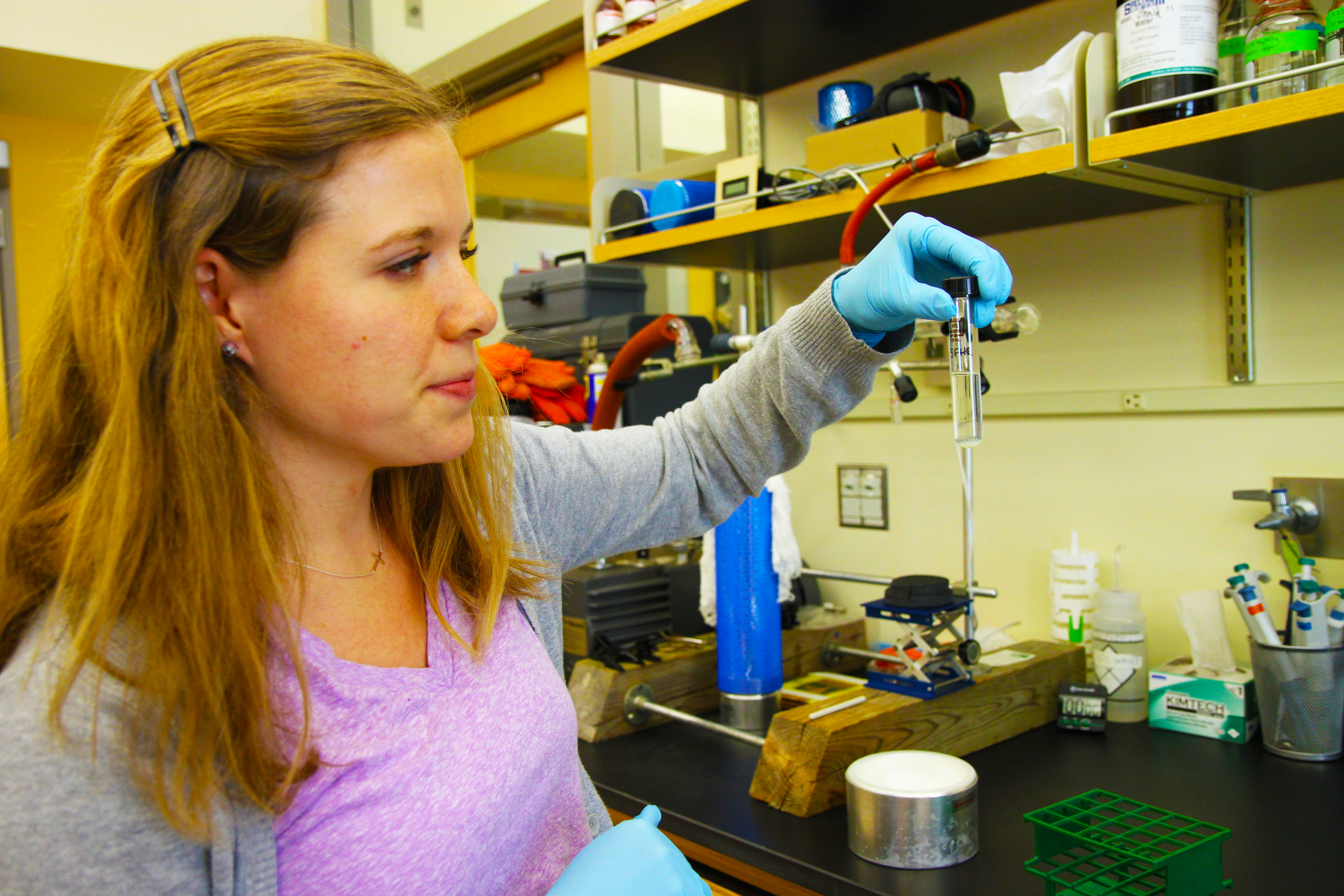Summer undergraduate research: Fralin Fellow advances collaborative research methods

The Virginia Tech Mass Spectrometry Research Incubator is an on-campus research hub for biochemical and molecular-level analyses, and this summer an undergraduate researcher is helping turn the wheel.
Whitney Beasley of Manassas, Virginia, a senior majoring in biochemistry in the College of Agriculture and Life Sciences and a Fralin Life Science Institute Summer Undergraduate Research Fellow, investigates the contents of samples from numerous Virginia Tech researchers asking one main question: What’s in the vial?
Consider the case of the Eastern hellbender, an Appalachian native and the largest aquatic salamander in North America. These creatures thrive in cold, freshwater mountain streams, which are typically low in pollutants, but with the high growth rate of human populations and land development, the hellbender’s ecosystem is in danger.
In an effort to analyze the health and wellbeing of the hellbender, researcher Bill Hopkins, a professor of fish and wildlife conservation in the College of Natural Resources and Environment and a Fralin Life Science Institute affiliate, sought out the incubator to catalog the biochemical makeup of hellbender blood serum. In addition, Hopkins investigates the reproductive biology of the hellbenders, which is where Beasley comes in.
Using these serum samples, Beasley discovers what the molecular makeup is with a particular goal of finding lipids.
"We’re given serum samples from the hellbenders that are about the volume of a raindrop. We want to fractionate the liquid into three different parts to make our analyses easier. One part, the organic phase, contains the lipids, another part contains the water-soluble components, and the bottom layer, which is a solid, has the serum proteins," said Beasley.
Once the samples are divided into three parts, Beasley uses the incubator’s high-resolution mass spectrometer – a device that detects the presence of compounds based on their mass – to identify lipids and determine their relative amounts. Organisms use certain kinds of lipids, such as steroids, to communicate messages at the whole body level using serum as the delivery system. The presence or absence of specific molecules can correlate to certain types of behavior, such as nesting behavior in salamanders.
In this case, the reason for the lipid search is to uncover male hellbenders’ unique reproductive responsibility: they build the nest and protect their eggs.
"I searched for the capabilities to identify the hellbender’s reproductive compounds, and I found that we have these capabilities right here on campus," said Hopkins. "The incubator is an ideal setting for us to address various sorts of questions. We can go from the organismal level out in the field all the way down to the biochemical and molecular level to understand what factors influence this imperiled animal’s physiology and its reproductive success. The results produced by the incubator may one day help us prevent this amazing salamander from going extinct."
Hopkins is just one researcher who makes use of the incubator, which is run by director Rich Helm, an associate professor of biochemistry in the College of Agriculture and Life Sciences and a Fralin Life Science Institute affiliate.
"We work with a number of investigators on campus who have samples that need to be analyzed, which means we need to have a standard protocol in place to analyze them," explained Helm. "Our lab is collaborative by nature and we are willing to give pretty much anything a look. The subsequent data analysis part, what we call the identification and validation phase, requires a significant commitment from our collaborators."
Beasley says the fellowship offers her the chance to work with advanced technology such as the mass spectrometer and learn how to apply it in a research setting.
"I have only done research in labs that are based on fieldwork, and I had never done any in-depth instrumental analysis. I’m used to dissecting things and looking at them with my eyes," said Beasley. "But I know that as a society, this is where we are heading. We can generate a huge amount of data with this type of analysis and working with it is quite a challenge."
With education as part of its initiative, Virginia Tech’s Mass Spectrometry Research Incubator is a collaborative research facility that provides a university-wide infrastructure for mass spectrometry-based analysis and education.
Along with Beasley, the incubator’s research team currently focuses on developing and applying methodologies for researchers interested in studying metabolites and proteins from all forms of life. These samples come from researchers across campus, so through collaboration, a vial’s contents can be understood in relation to the biological system under investigation.
The Virginia Tech Mass Spectrometry Research Incubator is funded primarily by the department of biochemistry and the Fralin Life Science Institute, as well as the Institute for Critical Technology and Applied Science, and the departments of animal and poultry sciences, biological sciences, chemistry, horticulture, human nutrition foods and exercise, and plant pathology physiology and weed science.
Beasley’s research interests stem from her love of science and her interest in both biology and chemistry. "I’m interested in the study of pathways and how organisms really work," said Beasley. "The nuts and bolts of how they work. That is, the study of life based on its building blocks."
During the summer of 2014, approximately 31 students are participating in Fralin Life Science Institute’s Summer Undergraduate Research Fellowship program. Students receive funding to pursue full-time independent research projects under the guidance of a faculty mentor. Project results will be presented at the Virginia Tech Summer Undergraduate Research Symposium held from 8 a.m. to 5 p.m. Thursday at the Graduate Life Center.
Written by Cassandra Hockman, communications assistant at the Fralin Life Science Institute.




